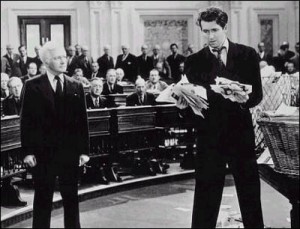In the third essay of Anatomy of Criticism Frye isolates four story shapes–romance, tragedy, irony/satire, and comedy–which he understands as stages in a hypothetically complete narrative structure. Romance and irony concern movement within, respectively, an idealized world and a world of experience; tragedy and comedy concern the direction of that movement. Frye outlines and illustrates in detail these “narrative pregeneric elements of literature,” or “generic plots,” which are “narrative categories broader than, or logically prior to, the ordinary literary genres” (162). Frye’s work has been, even if noted, generally ignored by narratologists. And yet its elegance–its simplicity, comprehensiveness, and explanatory power–which allows it to account for such an extraordinary diversity of narrative literature remains unparalleled. As it is impossible to outline Frye’s very complex argument here, I will content myself with a brief illustration of the dynamic nature of his view of narrative structure.
For the sake of demonstration, I would like to look at his understanding of comic plot and in particular the assertion in Frye’s “The Argument of Comedy” that “tragedy is really implicit or uncompleted comedy” and that “comedy contains a potential tragedy within itself” (65). This statement is crucial to Frye’s understanding of narrative structure as based on conventions that derive their logic from ritual, an assumption shared, among others, by a formalist approach to narrative such Vladmir Propp’s.
One of the modern masters of comic structure is the director Frank Capra, one of the great creators of American film comedy of the thirties and forties. In many of his films he was fond of bringing “his action,” to use Frye’s description, “as close to a tragic overthrow of the hero as he can get it, and [reversing] this movement as suddenly as possible” (65). This feature is central to the “U-shaped plot” of comedy, “with the action sinking into deep and often potentially tragic complications, and then suddenly turning upward into a happy ending” (FI 25). This darkening downturn near the end of his films, often noted by critics as a mark of Capra’s particular style, a part of his signature, is in fact, if we follow Frye, a conventional feature of comic structure in general. Frye calls it the point of ritual death, and he gives a formulation of it in the discussion of comedy in Anatomy. He speaks of the action of comedy as
mov[ing] toward a deliverance from something which, if absurd, is by no means invariably harmless. . . . Any reader can think of many comedies in which the fear of death, sometimes a hideous death, hangs over the central character to the end, and is dispelled so quickly that one has almost the sense of awakening from nightmare. . . . An extraordinary number of comic stories, both in drama and fiction, seem to approach a potentially tragic crisis near the end, a feature that I may call the “point of ritual death”–a clumsy expression that I would gladly surrender for a better one. It is a feature not often noticed by critics, but when it is present it is as unmistakably present as a stretto in a fugue, which it somewhat resembles. (178-79)
The hero or heroine in comedy, then, is at a certain point threatened with death or a displaced version of it (false accusation and imprisonment) and then at the last minute escapes. In Mr Deeds Goes to Town, Meet John Doe (which is not always thought of as a comedy), Mr Smith goes to Washington, and It’s A Wonderful Life, the hero struggles against insurmountable odds to overthrow a usurping, “humorous” society which threatens to destroy him and the ideals he represents. In each case, he is isolated and falsely accused by his enemies, and threatened with disgrace, imprisonment, or death. The point of ritual death in comedy corresponds to the death of the hero in tragedy, the phase of pathos in the complete structure of quest-romance; in comedy pathos is invoked, but a tragic result is avoided, often only narrowly.
In the first three of the abovementioned films, often seen as forming a trilogy, it is worth noting how the suggestion of crucifixion attaches to the hero at this point. The word crucifixion is in fact explicitly used in all three to describe the fate that awaits the hero, as he is falsely accused, set up in a mock trial, and then only at the last moment delivered from the hands of his enemies. Mr Deeds is imprisoned, put on trial to decide his sanity, and is about to be defeated because he refuses to speak and defend himself at his own hearing; at the last minute, the situation is turned around by the woman he loves who inspires him to break silence, and the humorous society is at the last moment routed: the film ends with Mr Deeds being carried out of the courtroom in triumph by a cheering crowd and then the couple escaping behind closed doors. In the last frame Mr Deeds picks up his “bride” and kisses her, in a classic comic ending. As formulated by Frye: “The resolution of comedy comes, so to speak, from the audience’s side of the stage; in a tragedy it comes from some mysterious world on the opposite side. In the movie, where darkness permits a more erotically oriented audience, the plot usually moves toward an act which, like death in Greek tragedy, takes place offstage, and is symbolized by a closing embrace” (164).
